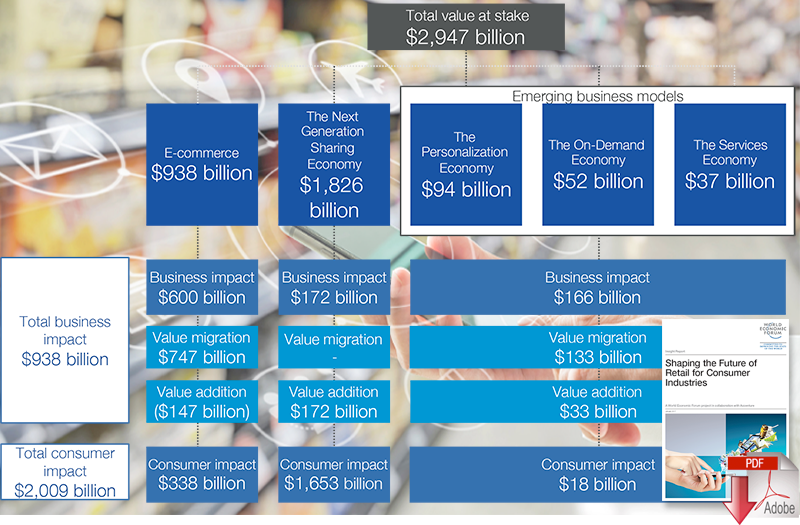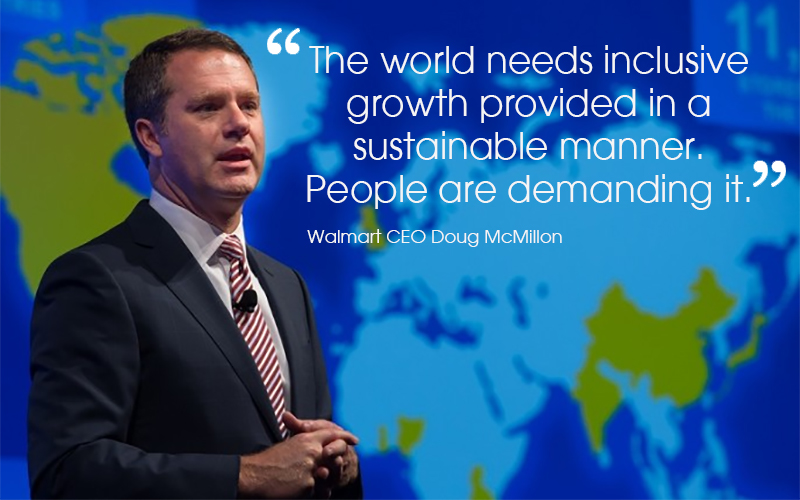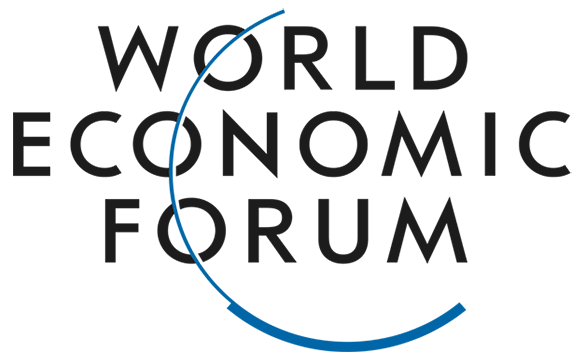3 Predictions for the Future of Retail from Walmart CEO Doug McMillon

What will shopping be like in 10 years? No one knows all the details (that’s exciting!), but one thing is for sure: it will be very different than it is today.
In the mid-19th century, most people in the U.S. were shopping at small markets.
They would tell the manager what they wanted, and then wait for the item to be retrieved from the back or from the supplier.
After that came the urban department store, supermarkets, then strip malls and discount stores.
Today, the pace of change is rapid.
Ten years ago most customers were reading about the original iPhone, and wondering whether it would be useful.
Now they expect to order something on their mobiles, have it delivered or pick it up in store - often on the same day, in a few hours, or even in a few minutes.
It’s up to retailers to adapt to these changes – and in some areas even lead the way - or they’ll fall behind and disappear.
Here’s what customers can expect their shopping experiences to be like 10 years from now:
1. Customer Empowerment and Even Greater Influence
Customer satisfaction has always been the number one goal for retailers, and in the future, customers will be more empowered than ever to drive the change they want, as they get more control over their shopping experience.
Technology - the internet, mobile and analytics - is being used to do anything and everything a customer doesn’t want to. Customers want to explore. But they need to have easy access to items they choose to use all the time.
The historic trade-off between price and service has been altered by technology and customers expect to save time and enjoy the experience while saving money.
They’ll fulfill their everyday needs - items like laundry detergent, paper, light bulbs, grocery staples and shampoo - in the easiest way possible through a combination of stores, e-commerce, pick-up, delivery and supported by artificial intelligence.
Download: Towards Purposeful Artificial Intelligence
Customer desires - think emerging fashion, fresh produce, and items they’ve never seen before - will still be fun to explore in stores as well as with technology (think virtual reality).
Retailers that provide a truly unique, enjoyable experience and prepare their associates to provide excellent service will have the advantage.
At Walmart they already see the value customers place on personalization and convenience, through our success with grocery pick-up and delivery in several markets around the world.
With the growth of the internet of things, customers will enjoy an increasingly connected or “smart” shopping experience through a network of connections linking the physical and digital worlds into an ecosystem of devices, including vehy icles, stores and software.
The internet of things, drones, delivery robots, 3D-printing and self-driving cars will allow retailers to further automate and optimize supply chains too. Both sides of the equation - demand and supply - will change dramatically.
Read More: Walmart Articles on Supply Chain 24/7
In addition, customers will continue to demand transparency around pricing and the supply chain. They’ll have less time to research the products they buy - but they’ll care even more about how they are sourced.
They’ll choose to shop with retailers who provide that transparency so they can feel good about the items they purchase. This will require retailers to work with manufacturers to source items responsibly and sustainably. Retailers who do this and share the information will further earn customers’ trust.
2. I’ve Seen What You Have and I Want It, Too
Customers all over the world now know, and can see, what people in other countries have, and they want access to it all. And they want it now.
Chinese customers want access to Louis Vuitton bags from France and milk from Australia.
Not long ago on a visit to Nigeria and Ghana, I asked one of our local store managers what his one wish would be. His answer:
“I want you to put a Walmart Supercenter like the ones you have in the US right here and let me run it. My customers and my family have seen what you have and we want it, too. We want those items at those prices.”
As Tom Friedman taught us, the world got flat and now it’s moving fast. The world needs inclusive growth provided in a sustainable manner. People are demanding it.
3. Shared Value
With all these changes, retailers will only survive if their business creates shared value that benefits shareholders and society.
Social and environmental sustainability will be engineered into our systems, and that will strengthen the communities in which we operate, which will in turn appeal to customers.
These changes, however, will require new levels of cooperation and collaboration between retailers and NGOs, governments and educational institutions.
Basically, we’ll design retail and other businesses so that all stakeholders (as many as possible) benefit: customers, associates/employees, shareholders, the communities we serve and those in the supply chain.
At Walmart, we’ve already found that investments in training, education and wages for our associates have resulted in higher customer satisfaction. Our customers want our associates to have a great life and they want to see that reflected in their attitudes and the service they provide.
When it comes to environmental sustainability, retailers and policy-makers face new challenges with the increase in packaging waste and emissions that comes with the growth of e-commerce.
Shipping packages one at a time is not only wasteful and environmentally unsustainable, it isn’t cost-effective.
The demand for convenience (see video above) will force retailers to come up with new ways to ship items - in batches vs. one at a time - that are better for business and the environment.
While all these changes pose big challenges for retailers, they also represent unprecedented opportunities to innovate on behalf of customers and create new job opportunities for retail associates.
I can’t think of a more exciting time to be in retail, to be at the forefront of change and part of an industry that has the potential to provide a better life for millions around the world.
Shaping the Future of Retail for Consumer Industries
Value framework for business models
For the purposes of this research, a unique value-at-stake framework has been developed to support a consistent approach to measuring the impact of these business models on the industry (business impact) and consumers (consumer impact).
This framework helps enterprises, policy-makers and regulators better understand the value that each business model in the retail sector can generate for both the industry itself and consumers.
The analysis projects that e-commerce and the four emerging business models – sharing economy, smart replenishment, curated subscription, and “do it for me” services - could unlock $2.95 trillion in value for the industry and consumers over the next decade.
Consumer benefits account for 68% of this value and industry benefits account for 32%.
Value at Stake for the Retail Industry
 Download the Paper: Shaping the Future of Retail for Consumer Industries
Download the Paper: Shaping the Future of Retail for Consumer Industries
Article Topics
World Economic Forum News & Resources
Adopting AI Responsibly Guidelines for Procurement of AI Solutions by the Private Sector The World Economic Forum Global Risks Report 2023 The Global Risks Report 2023 Extending ESG Best Practices Into the Supply Chain The Future of the Last-Mile Ecosystem Business Leaders Voice the Economic Impact of COVID-19 How Countries are Performing on the Road to Recovery More World Economic ForumLatest in Supply Chain
Microsoft Unveils New AI Innovations For Warehouses Let’s Spend Five Minutes Talking About ... Malaysia Baltimore Bridge Collapse: Impact on Freight Navigating TIm Cook Says Apple Plans to Increase Investments in Vietnam Amazon Logistics’ Growth Shakes Up Shipping Industry in 2023 Spotlight Startup: Cart.com is Reimagining Logistics Walmart and Swisslog Expand Partnership with New Texas Facility More Supply Chain
















